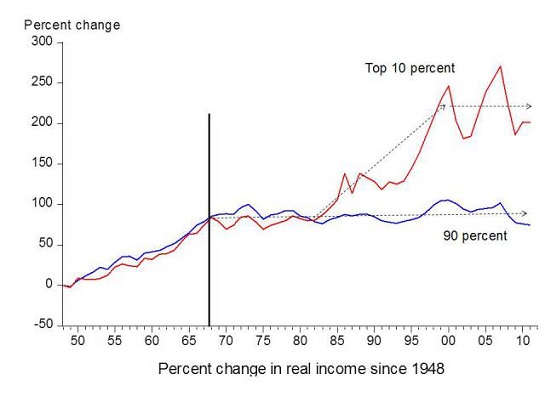Inflating serial asset bubbles is no
substitute for rising real incomes.
Why are we stuck with an economy that only
generates serial credit/asset bubbles that crash with catastrophic
consequences? Ths answer is actually fairly straightforward. Let’s
start with the ideal conditions for an economy that depends on
consumer spending.
1. Rising real income, i.e. after adjusting for
inflation/currency depreciation, wages/salaries have more purchasing
power every year.
2. An expanding pool of new households, i.e.
young people who move away from home or graduate from college, get a
job and start their own household. New households buy homes,
vehicles, furniture, appliances, kitchenware, tools, etc., driving
consumption far more than established households.
Neither of these conditions apply to today’s
economy. Income for the bottom 90% has been stagnant for
forty years, and has declined 7% in real terms since 2000.

This stagnation is not the “new normal”:
the new normal is much worse, as labor’s share of the national
income has fallen off a cliff:
Household formation has also stagnated. That
spike circa 2004-07 was caused by the housing bubble, which created
new jobs and collateral that could be leveraged into new home
purchases.
Since 2008, the Federal Reserve has bought $3.2
trillion in mortgages and Treasury bonds, and the Federal government
has borrowed and blown $7 trillion in deficit spending. That $10
trillion in stimulus (not counting $16 trillion in Fed loans to banks
and trillions more in other loans/subsidies), household formation has
only recovered to the sub-1 million a year level.
In an economy of 316 million people, that isn’t
enough to generate “growth” in a $16 trillion economy.
With these organic sources of growth
moribund or declining, the Fed and Federal government have resorted
to other ways of stimulating more borrowing and spending, the sources
of leveraged, high-risk “growth”:
1. Lower interest rates so stagnant income can
leverage more debt (and thus more spending)
2. Generate asset bubbles in stocks and housing
that boost “the wealth effect,” i.e. the emotional sense of being
wealthier as a result of one’s assets rising sharply in value, and
the collateral available to support more debt.
If a house rises by $100,000 in value in a few
short years, the owner has $100,000 more collateral to support new
debt. The gargantuan expansion of home equity lines of credit
(HELOCs) as the housing bubble expanded was the goal of the status
quo, as asset bubbles create collateral that supports new borrowing
and spending.
Now that interest rates are near-zero and
mortgage rates are rising from historic lows, there is no more juice
to be squeezed from low rates.
As for asset bubbles, they always burst,
destroying collateral and rendering borrowers and lenders alike
insolvent.
Without organic demand from rising real
income and new households with good-paying jobs and low levels of
debt, the consumer-debt based economy stagnates.This has left the
economy dependent on serial asset bubbles that create phantom
collateral that can support new debt, albeit temporarily.
Inflating serial asset bubbles is no substitute
for rising real incomes and new households that aren’t burdened
with high levels of debt from student loans.
No comments:
Post a Comment